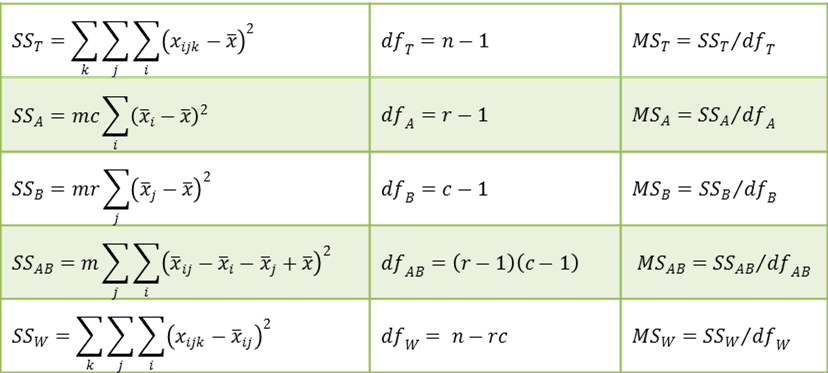Two-way MANOVA can be considered to be an extension of one-way MANOVA to support two factors and their interaction or as an extension to two-way ANOVA to support multiple dependent variables.
Univariate case
Two-way ANOVA investigates the effects of two categorical variables on a continuous outcome (the dependent variable). In two-way ANOVA, we have r random variables (the levels) for Factor A (the row factor) and c random variables for Factor B (the column factor). For each interaction between the factor levels, we have a sample with m elements (we restrict ourselves to the balanced model here). We can represent the sample for the ith level from Factor A and the jth level from Factor B by Xij = {xij1, …, xijm}.
Our objective is to test three types of null hypotheses:
H0: μ1. = μ2. = … = μr. (Factor A)
H0: μ.1 = μ.2 = … = μ.c (Factor B)
H0: δij= 0 for all i, j (Interaction between A and B, where the δij are the interaction effects
We define the following where n = mrc.

The test statistics F are defined as follows:
For each of the three null hypotheses, we reject the null hypothesis if F > Fcrit.
Multivariate case
As for one factor MANOVA, two-factor MANOVA is similar to two-factor ANOVA except that in place of simple variables (for each factor) we have random vectors and in place of sample data {xij1, …, xijm} for the ith level in Factor A and the jth level in Factor B, we have sample data {Xij1, …, Xijm} where each Xijk is a p × 1 column vector of data elements of the form xijkh. Here, there are p dependent variables.
The additive model takes the form:
![]()
This is exactly as for a two-factor ANOVA model except that xijk is replaced by Xijk and the other terms are column vectors instead of scalars. With this change, the null hypotheses are as for ANOVA. In place of the ANOVA normality assumption, assume multivariate normality, namely
The df terms are as for ANOVA, as defined above, and the SS terms are defined in terms of the following p × p cross-product matrices.
![]()
![]()
![]()
![]()
![]()
Recall from MANOVA Basic Concepts, that each of these SS matrices takes the form

where for SSA
and similarly for the other SS matrices.
Wilk’s Lambda
We can test each of the three null hypotheses using the appropriate Wilk’s Lambda.
![]()
If the Factor H null hypothesis is true (for H = A, B or AB) then
![]()
As for one factor MANOVA, a more accurate test is based on the F test, described as follows:

where![]()


 If either the numerator or denominator of b equals 0 or results in a negative value inside the square root, then b takes the value of 1.
If either the numerator or denominator of b equals 0 or results in a negative value inside the square root, then b takes the value of 1.
Hotelling-Lawley Trace
Each of the three null hypotheses is tested using the appropriate Hotelling-Lawley Trace test.
 Pillai-Bartlett Trace
Pillai-Bartlett Trace
Each of the three null hypotheses is tested using the appropriate Pillai-Bartlett Trace test.
Each of the three null hypotheses is tested using the appropriate Roy’s Largest Root test.

where![]()
![]() and s, t, u are as for the Pillai-Bartlett Trace test.
and s, t, u are as for the Pillai-Bartlett Trace test.
References
Ender, P. (2007) Multivariate Statistical Analysis
This document is no longer available on the Internet
Tsay, R.S. (2016) Applied Multivariate Analysis. Lecture Notes
https://faculty.chicagobooth.edu/ruey-s-tsay/research/multivariate-time-series-analysis-with-r-and-financial-applications
Penn State (2023) Two-way MANOVA additive model and assumptions
https://online.stat.psu.edu/stat505/lesson/8/8.10



